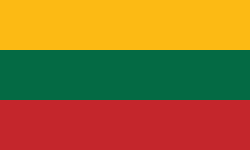Priekulė (Priekulė)
 |
Priekulė's name is known since the first half of the 16th century. At first it was named Paminia (at river Minia), and it was a small village with three homesteads. In 1511, a tavern "zur Minnige" is mentioned in written sources. In 1540, a certain Lukas Preckol is an owner of the tavern. It is believed that the town name was derived from Preckol's last name. The name "Precols" was recorded on region maps in 1548. A church was built in 1587 and a teacher was hired in 1594.
It was a part of the Polish–Lithuanian Commonwealth, as a fief of Poland, held by the Teutonic Knights and secular Ducal Prussia. In 1609 during the Polish–Swedish War (1600–1611), regiments of the Polish–Lithuanian cavalry plundered the town. In 1688 minister Wilhelm Martin built a new church. In 1773, it became part of the newly formed province of East Prussia within the Kingdom of Prussia, and from 1871 it was also part of Germany. In 1905 the village, now known as Prökuls, had 500 residents who were mostly Protestant Lutherans and mainly spoke the Memelland-Samogitian dialect.
In the course of the German revolutions on March 29, 1848, the local judiciary was demolished, the tax collector was mistreated and the pub was looted. The Prussian authorities put down the uprising on March 30th
Following the restoration of independent Lithuania in 1918, the town was acquired by Lithuania in 1923. Under German occupation during World War II, it was the location of the Oflag 63 prisoner-of-war camp for Allied officers.
On December 19, 2002 the city was granted coat of arms by the President of Lithuania.
Map - Priekulė (Priekulė)
Map
Country - Lithuanian_Soviet_Socialist_Republic_(1918–1919)
 |
 |
| Flag of Lithuania | |
Germany had lost World War I and signed the Compiègne Armistice on 11 November 1918. Its military forces then started retreating from the former Ober Ost territories. Two days later, the government of the Soviet Russia renounced the Treaty of Brest-Litovsk, which had assured Lithuania's independence. Soviet forces then launched a westward offensive against Estonia, Latvia, Lithuania, Poland and Ukraine in an effort to spread the global proletarian revolution and replace national independence movements with Soviet republics. Their forces followed retreating German troops and reached Lithuania by the end of December 1918.
Currency / Language
| ISO | Currency | Symbol | Significant figures |
|---|---|---|---|
| EUR | Euro | € | 2 |
| ISO | Language |
|---|---|
| LT | Lithuanian language |
| PL | Polish language |
| RU | Russian language |















